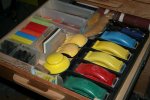- Messages
- 11,642
- Location
- Constantine, MI
When I went to put the finish on my small A&C clocks I was unable to get as dark a finish as I wanted. I thought I had followed all the same steps as I have in the past, but went back over my process just to be sure. My finish consists of a dye in DNA followed by dark walnut danish oil. There has always been the old saw, "when you think you're done sanding, sand some more", but I believe there is a flaw in that logic and I have fallen prey to it too often.
Retracing my steps I decided I was sanding too much, or, more accurately, to too fine a grit. I routinely begin with 150, and follow up with 180 and then 220 on a ROS. I believe my issue with not getting good penetration from the tinted oil is going beyond 180. I think I should stop there, or maybe sooner?
I went back and reread some of the finishing processes I've used in the past and found a disparity in final grit choices. In essence, when you want a finish to go deep, stop sanding at 150 or 180. Going further has the effect of 'polishing' the wood and making it resistant to penetrating stain. The exception seems to be on woods such ad curly or birds eye maple. There the experts seem to push to 220 if you are just using an oil (natural danish oil or BLO).
Finishing has always been a bit of a mystery to me, but I think I am sure of one thing - I probably sand too much.
Retracing my steps I decided I was sanding too much, or, more accurately, to too fine a grit. I routinely begin with 150, and follow up with 180 and then 220 on a ROS. I believe my issue with not getting good penetration from the tinted oil is going beyond 180. I think I should stop there, or maybe sooner?
I went back and reread some of the finishing processes I've used in the past and found a disparity in final grit choices. In essence, when you want a finish to go deep, stop sanding at 150 or 180. Going further has the effect of 'polishing' the wood and making it resistant to penetrating stain. The exception seems to be on woods such ad curly or birds eye maple. There the experts seem to push to 220 if you are just using an oil (natural danish oil or BLO).
Finishing has always been a bit of a mystery to me, but I think I am sure of one thing - I probably sand too much.


 ) is that:
) is that:

